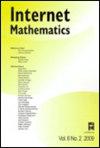Graph search via star sampling with and without replacement
Q3 Mathematics
引用次数: 1
Abstract
Star sampling (SS) is a random sampling procedure on a graph wherein each sample consists of a randomly selected vertex (the star center) and its (one-hop) neighbors (the star points). We consider the use of SS to find any member of a target set of vertices in a graph, where the figure of merit (cost) is either the expected number of samples (unit cost) or the expected number of star centers plus star points (linear cost) until a vertex in the target set is encountered, either as a star center or as a star point. We analyze these two performance measures on three related star sampling paradigms: SS with replacement (SSR), SS without center replacement (SSC), and SS without star replacement (SSS). Exact and approximate expressions are derived for the expected unit and linear costs of SSR, SSC, and SSS on Erdős-Renyi (ER) random graphs. The approximations are seen to be accurate. SSC/SSS are notably better than SSR under unit cost for low-density ER graphs, while SSS is notably better than SSR/SSC under linear cost for low- to moderate-density ER graphs. Simulations on twelve "real-world" graphs shows the cost approximations to be of variable quality: the SSR and SSC approximations are uniformly accurate, while the SSS approximation, derived for an ER graph, is of variable accuracy.图搜索通过星形采样与不替换
星形采样(SS)是图上的随机采样过程,其中每个样本由随机选择的顶点(星形中心)及其(一跳)邻居(星形点)组成。我们考虑使用SS来寻找图中目标顶点集的任何成员,其中优值(成本)是期望的样本数(单位成本)或期望的星形中心数加星形点(线性成本),直到遇到目标集中的顶点,无论是作为星形中心还是作为星形点。我们在三种相关的恒星采样范式上分析了这两种性能指标:有替换的SS(SSR)、没有中心替换的SS和没有恒星替换的SS。导出了Erdõs-Renyi(ER)随机图上SSR、SSC和SSS的期望单位和线性代价的精确和近似表达式。近似值被认为是准确的。对于低密度ER图,SSC/SSS在单位成本下明显优于SSR,而对于中低密度ER图而言,SSS在线性成本下显著优于SSR/SSC。对十二张“真实世界”图的模拟表明,成本近似具有可变的质量:SSR和SSC近似是一致精确的,而针对ER图推导的SSS近似具有可变精度。
本文章由计算机程序翻译,如有差异,请以英文原文为准。
求助全文
约1分钟内获得全文
求助全文

 求助内容:
求助内容: 应助结果提醒方式:
应助结果提醒方式:


